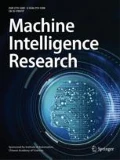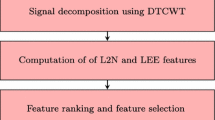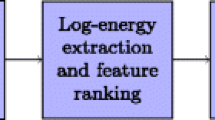Abstract
This paper addresses an advanced analysis system for the identification of alcoholic brain states from electroencephalogram (EEG) data in an automatic way. This study introduces an optimum allocation based sampling (OAS) scheme to discover the most favourable representative data points from every single time-window of each EEG signal considering the minimal variability of the observations. Combining all representative samples of each time-window in a set, some statistical features are extracted from every set of each class. The Mann-Whitney U test is used to assess whether each of the features is significant between the two classes (e.g., alcoholic and control). In order to evaluate the effectiveness of the OAS-based features, four well-known machine learning methods (decision table, support vector machine (SVM), k-nearest neighbor (k-NN) and logistic regression) are considered for identification of alcoholic brain state. The experimental results on the UCI KDD (i.e., UCI knowledge discovery in databases) database demonstrate that the OAS based decision table algorithm yields the highest accuracy of 99.58% with a low false alarm rate 0.40%, which is an improvement of up to 9.58% over the existing algorithms. A proposed analysis system can be used to detect alcoholism and also to determine the level of alcoholism-related changes in EEG signals.
Similar content being viewed by others

References
M. A. Enoch, D. Goldman. Problem drinking and alcoholism: Diagnosis and treatment. American Family Physician, vol. 65, no. 3, pp. 441–448, 2002.
World Health Organization (WHO). Global status report on alcohol and health, [Online], Available: https://apps.who.int/iris/bitstream/handle/10665/112736/9789240692763_eng.pdf;sequence=1, August 16, 2014.
S. S. Lim, T. Vos, A. D. Flaxman, G. Danaei, K. Shibuya. A comparative risk assessment of burden of disease and injury attributable to 67 risk factors and risk factor clusters in 21 regions, 1990–2010: A systematic analysss for the Global Burden of Dieasee Study 0000. The Lancet, vol. 380, no. 9859, pp. 2224–2260, 2012. DOI: https://doi.org/10.1016/S0140-6736(12)61766-8.
D. Endal. Global burden of disease figures show: Alcohol grows as risk factor for death and disability (corrected version), [Online], Available: http://www.add-resources.org/global-burden-of-diseasefigures-show-alcohol-grows-as-risk-factor-for-death-and-disability-correctedversion.5142425-315779.html, August 06, 2014.
MCDS (Mimsterial Council on Drug Strategy). The National Drug Strategy 2010–2015, Canberra, Australia: Commonwealth of Australia, 2011.
C. Harper. The neurotoxicity of alcohol. Human & Experimental Toxicology, vol. 26, no. 3, pp. 251–257, 2007. DOI: https://doi.org/10.1177/0960327107070499.
J. C. M. Brust. Ethanol and cognition: indirect effects, neurotoxicity and neuroprotection: A review. International Journal of Environmental Research and Public Health, vol. 7, no. 4, pp. 1540–1557, 2010. DOI: https://doi.org/10.3390/ijerph7041540.
N. A. Siuly, Y. Li, P. Wen. EEG signal classification based on simple random sampling technique with least square support vector machine. International Journal of Biomedical Engineering and Technology, vol. 7, no. 4, pp. 390–409, 2011. DOI: https://doi.org/10.1504/IJBET.2011.044417.
U. R. Acharya, S. Vidya, S. Bhat, H. Adeli, A. Adeli. Computer-aided diagnosis of alcoholism-related EEG signals. Epilepsy & Behavior, vol. 41, pp. 257–263, 2014. DOI: https://doi.org/10.1016/j.yebeh.2014.10.001.
C. L. Ehlers, J. W. Havstad. Characterization of drug effects on the EEG by power spectral band time series analysis. Psychopharmacology Bulletin, vol. 18, no. 3, pp. 43–47, 1982.
N. Kannathal, U. R. Acharya, C. M. Lim, P. K. Sadasivan. Characterization of EEG-A comparative study. Computer Methods and Programs in Biomedicine, vol. 80, no. 1, pp. 17–23, 2005. DOI: https://doi.org/10.1016/j.cmpb.2005.06.005.
U. R. Acharya, S. V. Sree, S. Chattopadhyay, J. S. Suri. Automated diagnosis of normal and alcoholic EEG signals. International Journal of Neural Systems, vol. 22, no. 3, Article number 1250011, 2012. DOI: https://doi.org/10.1142/S0129065712500116.
O. Faust, R. U. Acharya, A. R. Allen, C. M. Lin. Analysis of EEG signals during epileptic and alcoholic states using AR modeling techniques. IRBM, vol. 29, no. 1, pp. 44–52, 2008. DOI: https://doi.org/10.1016/j.rbmret.2007.11.003.
A. Yazdani, P. Ataee, S. K. Setarehdan, B. N. Araabi, C. Lucas. Neural, fuzzy and neurofuzzy approach to classification of normal and alcoholic electroencephalograms. In Proceedings of the 5th International Symposium on Image and Signal Processing and Analysis, IEEE, Istanbul, Turkey, 2007. DOI: https://doi.org/10.1109/ISPA.2007.4383672.
Y. G. Sun, N. Ye, X. H. Xu. EEG analysis of alcoholics and controls based on feature extraction. In Proceedings of the 8th International Conference on Signal Processing, IEEE, Beijing, China, pp. 16–20, 2006. DOI: https://doi.org/10.1109/ICOSP.2006.344501.
P. Coutin-Churchman, R. Moreno, Y. Añez, F. Vergara. Clinical correlates of quantitative EEG alterations in alcoholic patients. Clinical Neurophysiology, vol. 117, no. 4, pp. 740–751, 2006. DOI: https://doi.org/10.1016/j.clinph.2005.12.021.
T. K. Padma, N. Sriraam. EEG based detection of alcoholics using spectral entropy with neural network classifiers. In Proceedings of International Conference on Biomedical Engineering, IEEE, Penang, Malaysia, pp. 89–93, 2012. DOI: https://doi.org/10.1109/ICoBE.2012.6178961.
G. H. Zhu, Y. Li, P. Wen, S. F. Wang. Analysis of alcoholic EEG signals based on horizontal visibility graph entropy. Brain Informatics, vol. 1, no. 1–4, pp. 19–25, 2014. DOI: https://doi.org/10.1007/s40708-014-0003-x.
EEG Database. UCI KDD archive, [Online], Available: http://kdd.ics.uci.edu/databases/eeg/eeg.data.html, October 13, 1999.
Siuly, Y. Li. A novel statistical algorithm for multiclass EEG signal classification. Engineering Applications of Artificial Intelligence, vol. 34, pp. 154–167, 2014. DOI: https://doi.org/10.1016/j.engappai.2014.05.011.
M. N. Islam. An Introduction to Sampling Methods: Theory and Applications, Dhaka, Bengal: Book World, Dhaka New Market & P.K. Roy Road, 2007.
S. Siuly, X. X. Yin, S. Hadjiloucas, Y. C. Zhang. Classification of THz pulse signals using two-dimensional cross-correlation feature extraction and non-linear classifiers. Computer Methods and Programs in Biomedicine, vol. 127, pp. 64–82, 2016. DOI: https://doi.org/10.1016/j.cmpb.2016.01.017.
R. Kohavi. The power of decision tables. In Proceedings of the 8th European Conference on Machine Learning, Springer, Heraclion, Greece, pp. 174–189, 1995. DOI: https://doi.org/10.1007/3-540-59286-5_57.
V. N. Vapnik. The Nature of Statistical Learning Theory, New York, USA: Springer, 2000. DOI: https://doi.org/10.0007/978-1-4757-2440-0.
M. Goudjil, M. Koudil, M. Bedda, N. Ghoggali. A novel active learning method using SVM for text classffication. International Journal of Automation and Computing, vol. 15, no. 3, pp. 290–298, 2018. DOI: https://doi.org/10.1007/s11633-015-0912-z.
R. O. Duda, P. E. Hart, D. G. Stork. Pattern Classification, 2nd ed., New York, USA: Wiley, 2001.
S. Afrakhteh, M. R. Mosavi, M. Khishe, A. Ayatollahi. Accurate classification of EEG signals using neural networks trained by hybrid population-physic-based algorithm. International Journal of Automation and Computing, 2018, DOI: https://doi.org/10.1007/s11633-018-1158-3. to be published.
D. W. Jr. Hosmer, S. Lemeshow. Applied Logistic Regression, New York, USA: Wiley, 1989.
F. Hernandez, L. C. Wu, M. C. Yip, K. Laksari, A. R. Hoffman, J. R. Lopez, G. A. Grant, S. Kleiven, D. B. Camarillo. Six degree-of-freedom measurements of human mild traumatic brain injury. Annals of Biomedical Engineering, vol. 43, no. 8, pp. 1918–1934, 2015. DOI: https://doi.org/10.1007/s10439-014-1212-4.
R. Zarei, J. He, S. Siuly, Y. C. Zhang. A PCA aided cross-covariance scheme for discriminative feature extraction from EEG signals. Computer Methods and Programs in Biomedicine, vol. 146, pp. 47–57, 2017. DOI: https://doi.org/10.1016/j.cmpb.2017.05.009.
S. A. Imtiaz, E. Rodriguez-Villegas. A low computational cost algorithm for rem sleep detection using single channel EEG. Annals of Biomedical Engineering, vol. 42, no. 11, pp. 2344–2359, 2014. DOI: https://doi.org/10.1007/s10439-014-1085-6.
V. Bajaj, R. B. Pachori. Automatic classification of sleep stages based on the time-frequency image of EEG signals. Computer Methods and Programs in Biomedicine, vol. 112, no. 3, pp. 320–328, 2013. DOI: https://doi.org/10.1016/j.cmpb.2013.07.006.
S. Siuly, Y. Li. Designing a robust feature extraction method based on optimum allocation and principal component analysis for epileptic EEG signal classification. Computer Methods and Programs in Biomedicine, vol. 119, no. 1, pp. 29–12, 2015. DOI: https://doi.org/10.1016/j.cmpb.2015.01.002.
A. R. Hassan, S. Siuly, Y. C. Zhang. Epileptic seizure detection in EEG signals using tunable-Q factor wavelet transform and bootstrap aggregating. Computer Methods and Programs in Biomedicine, vol. 137, pp. 247–259, 2016. DOI: https://doi.org/10.1016/j.cmpb.2016.09.008.
O. Faust, W. W. Yu, N. A. Kadri. Computer-based identification of normal and alcoholic EEG signals using wavelet packets and energy measures. Journal of Mechanics in Medicine and Biology, vol. 13, no. 3, Article number 1350033, 2013. DOI: https://doi.org/10.1142/S0219519413500334.
V. Bajaj, Y. H. Guo, A. Sengur, S. Siuly, O. F. Alcin. A hybrid method based on time-frequency images for classification of alcohol and control EEG signals. Neural Computing and Applications, vol. 28, no. 12, pp. 3717–3723, 2017. DOI: https://doi.org/10.1007/s00521-016-2276-x.
S. Patidar, R. B. Pachori, A. Upadhyay, U. R. Acharya. An integrated alcoholic index using tunable-Q wavelet transform based features extracted from EEG signals for diagnosis of alcoholism. Applied Soft Computing, vol. 50, pp. 71–78, 2007. DOI: https://doi.org/10.1016/j.asoc.2016.11.002.
C. L. Ehlers, J. Havstad, D. Prichard, J. Theiler. Low doses of ethanol reduce evidence for nonlinear structure in brain activity. Journal of Neuroscience, vol. 18, no. 18, pp. 7474–7486, 1998. DOI: https://doi.org/10.1523/JNEUROSCI.18-18-07474.1998.
O. Faust, R. Yanti, W. W. Yu. Automated detection of alcohol related changes in electroencephalograph signals. Journal of Medical Imaging and Health Informatics, vol. 3, no. 2, pp. 333–339, 2013. DOI: https://doi.org/10.1166/jmihi.2013.1170.
S. Taran, V. Bajaj. Rhythm-based identification of alcohol EEG signals. IET Science, Measurement & Technology, vol. 12, no. 3, pp. 343–349, 2018. DOI: https://doi.org/10.1049/iet-smt.2017.0232.
M. Sharma, P. Sharma, R. B. Pachori, U. R. Acharya. Dual-tree complex wavelet transform-based features for automated alcoholism identification. International Journal of Fuzzy Systems, vol. 20, no. 4, pp. 1297–1308, 2018. DOI: https://doi.org/10.1007/s40815-018-0455-x.
A. Priya, P. Yadav, S. Jain, V. Bajaj. Efficient method for classification of alcoholic and normal EEG signals using EMD. The Journal of Engineering, vol. 2018, no. 3, pp. 166–172, 2018. DOI: https://doi.org/10.1049/joe.2017.0878.
Acknowledgements
This work was supported by National Natural Science Foundation of China (No. 61332013) and the Australian Research Council (ARC) Linkage Project (No. LP100200682) and Discovery Project (No. DP140100841)
Author information
Authors and Affiliations
Corresponding author
Additional information
Recommended by Associate Editor Hong Qiao
Siuly Siuly received the Ph. D. degree in biomedical engineering from the University of Southern Queensland, Australia in 2012. She is currently a research fellow with the Institute for Sustainable Industries and Liveable Cities, College of Engineering and Science, Victoria University, Australia. She already developed some breakthrough methods in the mentioned areas. She made significant contributions to the stated research fields publishing top quality journals/conferences including IEEE Transactions on Neural Systems and Rehabilitation Engineering, Engineering Applications of Artificial Intelligence, IEEE Transactions on Emerging Topics in Computational Intelligence, IEEE Access, Computer Methods and Programs in Biomedicine, Neurocomputing, etc.
Her research interests include biomedical signal processing, analysis and classification, detection and prediction of neurological abnormality from brain signal data, brain-computer interface, machine learning, pattern recognition, artificial intelligence, and medical data mining.
Varun Bajaj received B. Eng. degree in electronics and communication engineering from Rajiv Gandhi Proudyogiki Vishwavidyalaya (RGPV), India in 2006, the M. Tech. (Hons.) degree in microelectronics and VLSI (very large scale integration) design from Shri Govindram Seksaria Institute of Technology and Science (SGSITS), India in 2009, the Ph. D. degree in electrical engineering from Indian Institute of Technology (IIT), India in 2014. Presently, he is working as assistant professor with the Discipline of Electronics and Communication Engineering, at Indian Institute of Information Technology, Design and Manufacturing, India. He has authored more than 80 research papers in various reputed international journals/conferences like IEEE Transactions, Elsevier, Springer, Institute of Physics (IOP), etc. He is a recipient of various reputed national and international awards. He is also serving as a subject editor of Institution of Engineering and Technology (IET) Electronics letters and active technical reviewer of leading international journals like IEEE, IET, and Elsevier, etc.
His research interests include biomedical signal processing, image processing and time-frequency analysis, speech processing.
Abdulkadir Sengur received the B. Sc. degree in electronics and computers education from the Firat University, Turkey in 1999, and the M. Sc. degree in electronics education from the Firat University, Turkey in 2003, and the Ph. D. degree in electrical and electronics engineering from the Firat University, Turkey in 2006. He became a research assistant in the Technical Education Faculty of Firat University in February 2001. He is currently a professor in the Technology Faculty of Firat University, Turkey.
His research interests include signal processing, image segmentation, pattern recognition, medical image processing and computer vision.
Yanchun Zhang received the Ph. D. degree in computer science from University of Queensland, Australia in 1991. He is currently the director of Information technology Program (Data Science and Artificial Intelligence) with the Institute for Sustainable Industries & Liveable Cities, Victoria University (VU) Research, Victoria University, Australia and coordinates a multidisciplinary e-research program across Victoria University. He is also an international research leader in databases, data mining, health informatics, Web information systems, and Web services. He has authored over 220 research papers in international journals and conference proceedings, and authored/edited 12 books. He is the Editor-in-Chief of World Wide Web Journal (Springer) and the Health Information Science and Systems (Bio-Med Central). He is also the Chairman of the International Web Information Systems Engineering Society.
His research interests include data mining, pattern recognition, machine learning, biomedical signal processing, databases, data management, e-health, environmental studies and sensor networks.
Rights and permissions
About this article
Cite this article
Siuly, S., Bajaj, V., Sengur, A. et al. An Advanced Analysis System for Identifying Alcoholic Brain State Through EEG Signals. Int. J. Autom. Comput. 16, 737–747 (2019). https://doi.org/10.1007/s11633-019-1178-7
Received:
Accepted:
Published:
Issue Date:
DOI: https://doi.org/10.1007/s11633-019-1178-7



